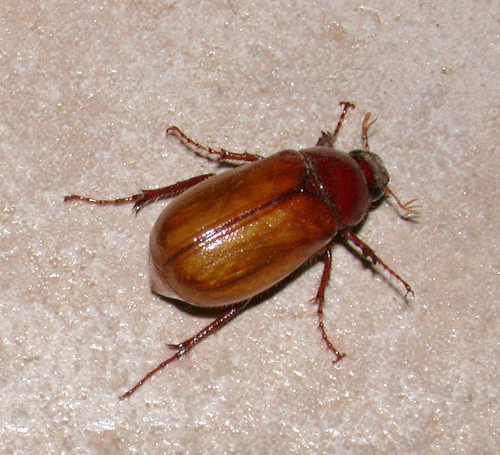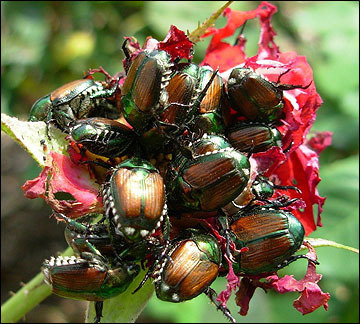Terminalcoffee discussion
Sally's socket
>
Reason # 302 why I hate this time of year (Jim and Larry test their theories) Arachnophiles come on in! Arachnophobes, beware,
message 101:
by
Félix
(new)
Dec 08, 2012 02:47PM
 What does a Christmas beetle look like?
What does a Christmas beetle look like?
reply
|
flag
They are about an inch long the hard wing covers are tan with small indented black spots. The head section is tan with iridescent colours. I haven't seen one since living in Sydney. I'll try and find a picture.
 Gail wrote: "I love this time of year. It reminds me of some happy times when I was a kid. I would wake up to the roar of cicadas, signaling a blistering hot day, king tides, lovely clear deep water in the cre..."
Gail wrote: "I love this time of year. It reminds me of some happy times when I was a kid. I would wake up to the roar of cicadas, signaling a blistering hot day, king tides, lovely clear deep water in the cre..."That is exactly how it was! I loved those beetles too. Dad would shake the little gum tree out the front of our house and we would pick up the beetles when they fell on the grass.
If they make a Mini Cooper in similar colours. It would be hard to tell them apart.
 I haven't seen one since my childhood. We did live in a very bushy environment though. On a hot summer night, the beetles would would cling to the wire screen door. They were attracted to the interior lights . Gail has made me feel very nostalgic.
I haven't seen one since my childhood. We did live in a very bushy environment though. On a hot summer night, the beetles would would cling to the wire screen door. They were attracted to the interior lights . Gail has made me feel very nostalgic.*hums Waltzing Matilda*
 Gail wrote: "I love this time of year. It reminds me of some happy times when I was a kid. I would wake up to the roar of cicadas, signaling a blistering hot day, king tides, lovely clear deep water in the cre..."
Gail wrote: "I love this time of year. It reminds me of some happy times when I was a kid. I would wake up to the roar of cicadas, signaling a blistering hot day, king tides, lovely clear deep water in the cre..."Where did you grow up, Gail? I was in Oyster Bay in the Sutherland Shire.
Probably from the same family.
Evie I grew up in Port Stephens.
You don't find these around street lights though. Here is a picture of one. The pretty iridence colours don't show up in this photo.


 That is a cute bug! Lovely nostalgia, Gail and Evie.
That is a cute bug! Lovely nostalgia, Gail and Evie.Reminds me of when the fireflies come out in the summer.
 Gail wrote: "You don't find these around street lights though. Here is a picture of one. The pretty iridence colours don't show up in this photo.
Gail wrote: "You don't find these around street lights though. Here is a picture of one. The pretty iridence colours don't show up in this photo."
Gail! That's them . The colours were beautiful, and so were their little faces.
 Félix wrote: "And eat them? No, you didn't eat them."
Félix wrote: "And eat them? No, you didn't eat them."We would look at them, Felix. We would do the same with cicadas.
We were not allowed to keep them. Too cruel.
 These toads are taking up a lot of space over here. First introduced in QLD to eat the cane beetle, they are now inhabiting W.A on the other side of the country.
These toads are taking up a lot of space over here. First introduced in QLD to eat the cane beetle, they are now inhabiting W.A on the other side of the country. 
 The cane toad (Bufo marinus), also known as the giant neotropical toad or marine toad, is a large, terrestrial true toad which is native to Central and South America, but has been introduced to various islands throughout Oceania and the Caribbean. It is a member of the subgenus Rhinella of the genus Bufo, which includes many different true toad species found throughout Central and South America. The cane toad is a prolific breeder; females lay single-clump spawns with thousands of eggs. Its reproductive success is partly because of opportunistic feeding: it has a diet, unusual among anurans, of both dead and living matter. Adults average 10–15 cm (3.9–5.9 in) in length; the largest recorded specimen weighed 2.65 kg (5.8 lb) with a length of 38 cm (15 in) from snout to vent.
The cane toad (Bufo marinus), also known as the giant neotropical toad or marine toad, is a large, terrestrial true toad which is native to Central and South America, but has been introduced to various islands throughout Oceania and the Caribbean. It is a member of the subgenus Rhinella of the genus Bufo, which includes many different true toad species found throughout Central and South America. The cane toad is a prolific breeder; females lay single-clump spawns with thousands of eggs. Its reproductive success is partly because of opportunistic feeding: it has a diet, unusual among anurans, of both dead and living matter. Adults average 10–15 cm (3.9–5.9 in) in length; the largest recorded specimen weighed 2.65 kg (5.8 lb) with a length of 38 cm (15 in) from snout to vent.The cane toad is an old species. A fossil toad (specimen UCMP 41159) from the La Venta fauna of the late Miocene of Colombia is indistinguishable from modern cane toads from northern South America. It was discovered in a floodplain deposit, which suggests the B. marinus habitat preferences have always been for open areas.
The cane toad has poison glands, and the tadpoles are highly toxic to most animals if ingested. Because of its voracious appetite, the cane toad has been introduced to many regions of the Pacific and the Caribbean islands as a method of agricultural pest control. The species derives its common name from its use against the cane beetle (Dermolepida albohirtum). The cane toad is now considered a pest and an invasive species in many of its introduced regions; of particular concern is its toxic skin, which kills many animals—native predators and otherwise—when ingested.
Cut out the name calling you two! Someone might get hurt.
 evie wrote: "These come into the house!
evie wrote: "These come into the house!"
Invited or uninvited? I know some of you spare these creatures, but it would be dead in my house.
Those are harmless, they come inside only when it rains. I love them and make sure no harm comes to them. Some times they need a little gentle assistance to take them back where they belong.
 At first glance, my daughter thought our recent visitation was a mouse running along the carpet. It was not a little spider.
At first glance, my daughter thought our recent visitation was a mouse running along the carpet. It was not a little spider.
I suffer no spiders! As long as they stay in their own zone, I live & let live. As soon as they venture into mine, all bets are off.
Having three cats helps. They eat most things.
 That is a large spider! We have seen at least 8 Black Widows in our yard. They are of the .01% that are harmful but we just leave them alone.
That is a large spider! We have seen at least 8 Black Widows in our yard. They are of the .01% that are harmful but we just leave them alone.
 Susan wrote: "That is a large spider! We have seen at least 8 Black Widows in our yard. They are of the .01% that are harmful but we just leave them alone."
Susan wrote: "That is a large spider! We have seen at least 8 Black Widows in our yard. They are of the .01% that are harmful but we just leave them alone."Good idea.
We had a plague of red backs in our garden for two summers running when my daughter was young.

 I saw this yesterday in my back yard. A spider wasp dragging its prey. The paralysed Huntsman is fresh meat for its new young.
I saw this yesterday in my back yard. A spider wasp dragging its prey. The paralysed Huntsman is fresh meat for its new young.
 Does it lay eggs inside the paralyzed spider? Mrs. Phil saw a wasp dragging a spider at our house a month or so ago, and someone at her work told her that's what happens.
Does it lay eggs inside the paralyzed spider? Mrs. Phil saw a wasp dragging a spider at our house a month or so ago, and someone at her work told her that's what happens.







